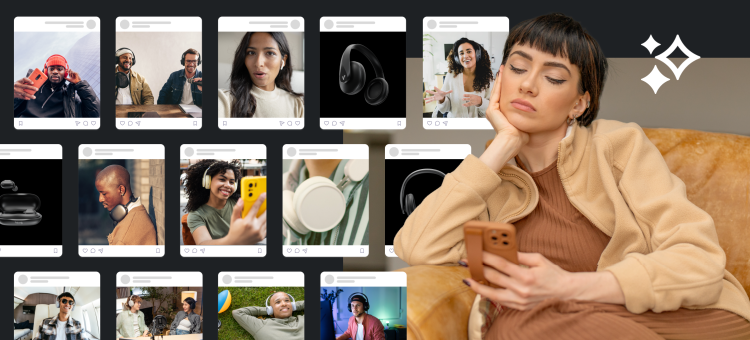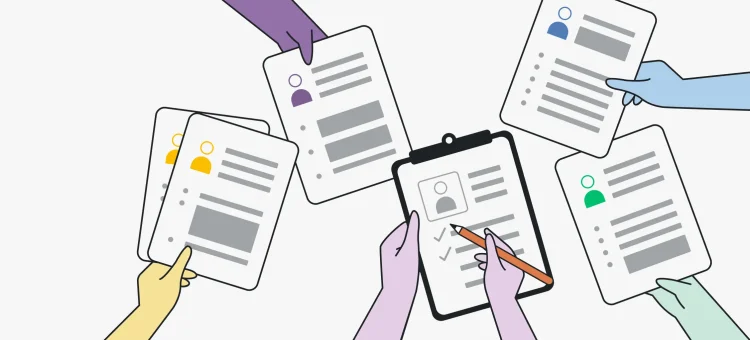The workplace has fundamentally changed over the past five years. The boundaries between work and personal life have blurred and many employees are committed to this more fluid work style. The workforce is now made up of six generations, all who have markedly different work ethics and values.
In our study, we looked at these generational differences, plus how workers feel about their jobs, their pet peeves, their strategy for getting ahead, and the gap in remote and in-office workers' perceptions.
1. Employee confessions: personal and professional time is often blurred
The 40-hour work week is still the standard for most companies, but when, where, and how the work happens is up for interpretation. From multitasking on calls to taking a few hours off or unreported vacation time—employees are making their own rules to accommodate the demands of high-pressure work environments.
One of the most talked about trends is “quiet vacationing,” where employees work while on vacation without officially taking time off and telling their manager. This trend started during the pandemic, but the practice has expanded in the past year.
In our study, 32% of hybrid and remote workers admit to taking a quiet vacation at least once in the last year. Younger generations are the most likely to jump on the trend with 41% of Gen Z and 36% of Millennials saying they took a quiet vacation in the past year, compared to 27% of Gen X.
Multitasking is part of work day
If you’ve ever wondered what’s going on when a colleague’s background is blurred or their camera is off, the answer is—it depends.
In our study, half of hybrid or remote workers admit to multitasking during a work call, almost a third (29%) have used the bathroom and two out of ten have browsed social media. Another 14% have done online shopping and 12% have done laundry.
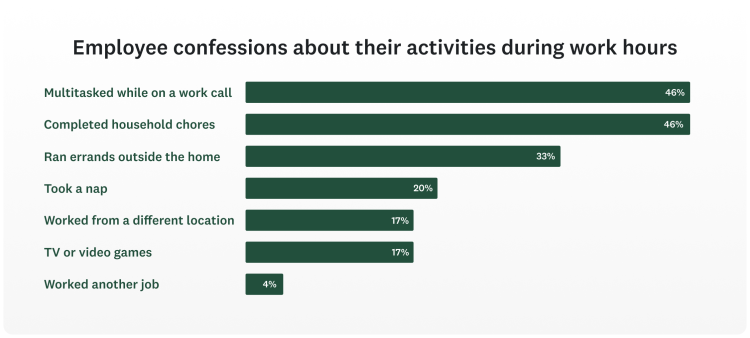
Generations think about work life balance differently
With all the talk of a six-generation workforce, companies might find it hard to make generalizations about what employees are inclined to do. Our study looked at how working behaviors varied based on age. Here’s a quick list:
- 31% of Gen Z have worked from another location without telling anyone compared to 16% of Gen X
- 26% of Millennials admit to taking a nap during the work day compared to 16% of Gen X
- 18% of Gen Z have worked another job during work hours compared to 2% of Gen X and 1% of Boomers
2. Work environments shape the employee experience
As the dust settles around a reshaped workplace, workers find themselves assessing their choice (or option) to work remotely, in office, or hybrid. We asked workers about their productivity, satisfaction levels, and pet peeves and compared the differences.
Overall, employees are aligned on their job satisfaction regardless of where they work. In our study, three quarters of hybrid and in-person workers said they liked their job. A larger number of remote workers (82%) have positive feelings about work than employees in other work arrangements.
Remote workers are also more likely to overachieve, with 40% saying they would go the extra mile compared to about 35% of hybrid and in-person employees.
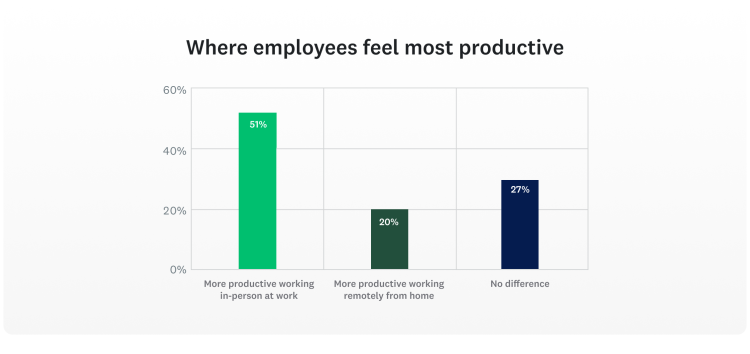
However, in-person employees also appear most likely to feel the stress of the workplace, with almost half saying that its more stressful now than over the past five years. Remote workers are the least likely to feel stressed with almost the same percentage (45%) saying they are feeling less stress.
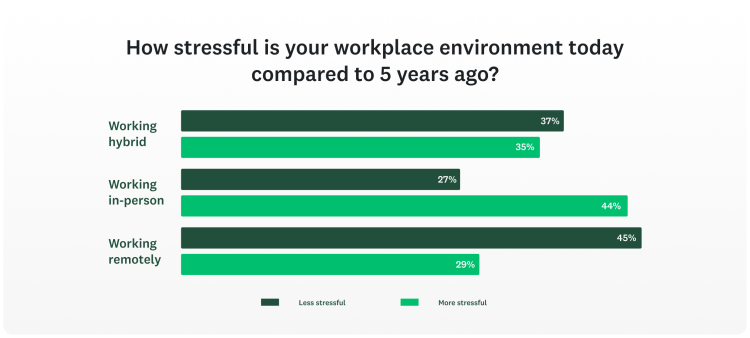
Pet peeves vary based on the employees' workplace. For remote employees, micromanagement and unnecessary meetings top the list of annoyances. For in-person workers, office drama and micromanagement are the top annoyances, where hybrid workers are most irritated by meetings that could be emails.
It’s not a perfect world for remote workers. Employees who work from home do miss some of the perks of being in the office. Topping the list, 40% miss socializing with coworkers, and 17% admit they would have better communications with their team in person. Only 10% miss in-person meetings or brainstorms, which came in at number three.
3. Job satisfaction and work life balance
Somehow, employees managed to come out of the last five years with a pretty positive outlook. Almost half of all employees (44%) say they love their jobs and another 32% like their jobs. Over three quarters (78%) say their job gives their life meaning—a surprising takeaway from a workforce that considered things like quiet quitting only a few years ago.
Another telling stat, over half (53%) of workers say they would not quit their job if they won the lottery.
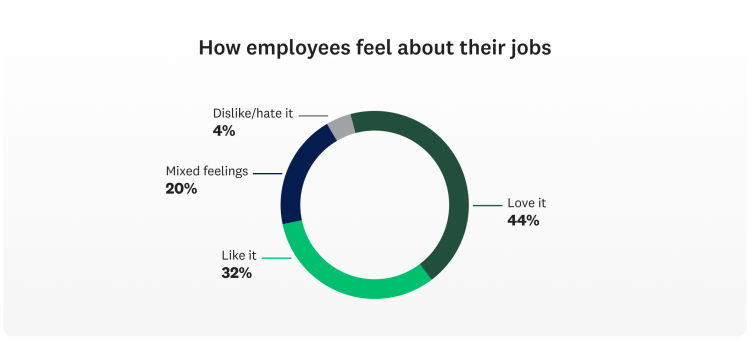
Job hopping varies by generation
Contrary to recent headlines about job-hopping, our study showed that 74% of workers say its better to stay at one company than switch jobs every few years. That holds for all generations, however younger generations are less likely to believe it's best to stay in one place; 73% of Gen Z agree with staying at one company compared to 80% of Boomers.
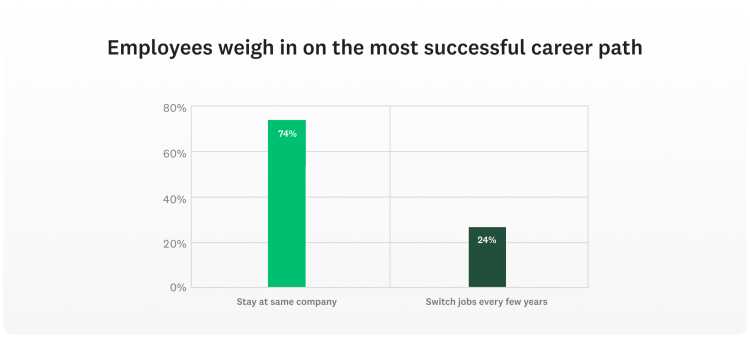
Personal time hard to carve out for many employees
Quiet vacationing or multi-tasking during a work call could be interpreted as slacker behavior, but the fact is that employees are responding to increasing pressure in the workplace with these less conventional practices.
Instead of asking permission, workers are finding their own way to balance work with their personal lives. Younger workers are less likely to ask for permission, and are quietly rebelling against the “rise and grind” values of previous generations.
Nearly one in five (18%) workers have used sick days for vacation, driven by Gen Z and Millennials. In addition, 36% of Gen Z and Millennial workers have used sick time for mental health days, compared with 30% of Gen X workers.
While taking a vacation without reporting it to your company might seem sketchy, it actually cuts both ways. Employees are finding it difficult to completely unplug from their jobs, even when they do take time off.
Over half of employees report checking work email while on vacation, and 28% say they are asked to do work while on vacation. Hybrid (67%) and remote workers (56%) are more likely to check their email on vacation, compared to 52% of in-person workers.
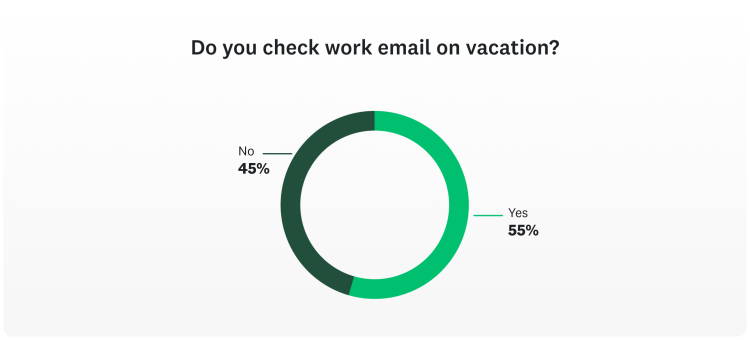
As with other behaviors, this varies by generation. Only a quarter (25%) of Gen Z say they have difficulty disconnecting from work on vacation compared to a third of millennials and Gen X and 36% of Boomers.
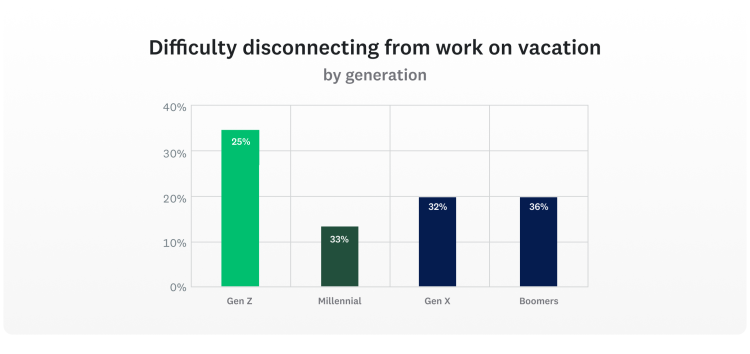
Hybrid workers also have a more difficult time letting go of work while on vacation, with 43% saying they struggle to disconnect, compared to 31% of remote or in-person employees.
How are your employees feeling about their workplace culture?
Building a modern workforce means understanding what people think and delivering on their needs. We’ve made it easy to ask the right questions to get real answers from employees. Check out our templates for HR, plus tools and resources to manage workplace wellbeing.
Methodology: SurveyMonkey “Workplace trends” study was conducted August 5-14, 2024 among a sample of 3,117 full-time workers in the US. Respondents were selected from a non-probability online panel. The modeled error estimate for these surveys is plus or minus 1.0 percentage point. Data has been weighted for age, race, sex, education, and geography using the Census Bureau’s American Community Survey to reflect the overall demographic composition of the United States.


